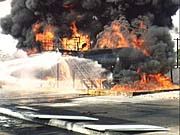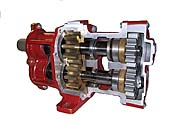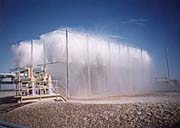Editor's Note: The pump curves referenced in this article could not be reproduced online. Please see the print edition for this information.
Positive displacement pumps have been used in fire protection for many years. In fact, they were the first pump type to be utilized for mobile fire truck applications, long before centrifugal pump designs were used for pumping fire water. Rotary gear pumps were employed because of their ability to pump water via long hose or piping lengths. Positive displacement pumps, by nature, are capable of high discharge pressures, something the fire service requires for many types of fire fighting.
As pumping technology progressed, centrifugal pump design matured. Single stage and multiple stage centrifugal pumps were developed, primarily to meet non-fire protection industrial requirements, though it was inevitable that centrifugal pumps would end up being used for pumping water in stationary fire protection systems.

Early in the history of fire protection, water additives were discovered that could be more beneficial when fighting flammable liquid fires vs. using plain water. This led to the need for a pump that could handle pumping foam concentrate. And, due to the unique physical characteristics of foam concentrate, positive displacement pumps proved to be the best choice for this service due to their high discharge pressure capability.
Since those early foam applications, rotary gear pumps have become the worldwide choice for the pumping and injection of foam concentrate into the water stream. Positive displacement rotary gear pumps are installed in various critical high-hazard installations worldwide, working side-by-side with centrifugal pumps to ensure the best in fire protection that is available.
Centrifugal fire pumps have evolved to produce operating efficiencies that often exceed 70% efficiency with a wide variety of pump configurations. Whether the water flow requirements are 300 gpm or 3,000 gpm, there is a UL-listed and/or FM-approved centrifugal fire pump to fit the application. Typical centrifugal pump styles used for fire protection service include vertical inline design, end suction, vertical turbine and horizontal split-case design pumps. Today, centrifugal fire pumps are exclusively used for traditional sprinkler-type water applications in fire protection. However, there is a new, emerging technology for which positive displacement pumps are the better choice. This new application of positive displacement has once again raised awareness and interest in applying positive displacement pumps for special hazard fire protection systems. This new technology is the water mist fire protection system.
Positive displacement pumps typically offer lower flow rate and higher discharge pressure capabilities than centrifugal pumps. Thus, it is now common to see piston pumps, plunger pumps and rotary gear pumps specified for supplying water at high pressures to a water mist system. Typical discharge pressures range from a low of 175 psig to 3,000 psig for water mist applications.

Positive displacement pump construction, as shown here, is vastly different from the more common centrifugal pumps, thus different criteria apply when using this pump in fire protection applications.
NFPA Recognizes Positive Displacement Pumps
The role that the positive displacement pump plays in fire protection has evolved into a growing use with special hazard fire protection systems, combined with traditional use with foam concentrate systems. In the more recent past, the National Fire Protection Association (NFPA) recognized the fact that positive displacement pumps are better suited for foam concentrate and water mist system applications than more traditional centrifugal pumps. Consequently, the 1999 version of NFPA 20, "Standard for the installation of Stationary Pumps for Fire Protection," was rewritten to include an entire chapter on positive displacement pumps.
This was a major undertaking for the NFPA 20 committee; however, the NFPA Standards Council knew that it was essential to address positive displacement pumps due to the increasing application of these types of pumps in the fire protection industry and their suitability for foam and water mist. The new chapter has specific language that guides a user or design engineer in selecting and applying a positive displacement pump for both foam and water service. Prior to the 1999 version, NFPA 20 was strictly confined to the design and application of centrifugal fire pumps for traditional water-only fire protection systems. There were no NFPA documents or guides for properly applying positive displacement pumps in any fire protection service. The foam standard, NFPA 11, did address positive displacement pumps but not in detail. The water mist standard, NFPA 750, is a new standard and did not address mist pumps in detail.
A key part of the new chapter 5 in NFPA 20 is the requirement for the positive displacement pump to be "listed" for the intended service. This means that the foam or water mist pump must have a third party listing, regardless of use or application. The ultimate authority, however, is the Authority Having Jurisdiction (AHJ) regarding the choice of either or both UL and FM listings, or no listing requirements at all, for foam or water mist positive displacement pumps.
Meanwhile, centrifugal pump manufacturers work hard to improve pump efficiencies and lower costs in an increasingly more competitive market, while positive displacement pump manufacturers explore new technology and applications for a very old pump design concept that has received renewed interest.

A common application for positive displacement pumps is in water mist systems.
Choosing the Correct Pump
Applying either centrifugal or positive displacement pumps properly requires keen engineering review and consideration of site conditions and system intent. Each pump type can offer benefits and/or disadvantages in various fire protection applications. For example, positive displacement pumps must have a safety relief valve added to the pump discharge pipe to prevent excessive pressure build-up. These safety valves must pass 100% of the pump's capacity. In addition, positive displacement pumps generally operate at rpms well below centrifugal pumps. Designers must take into consideration that the pump performance curves are vastly different between centrifugal and positive displacement, which may make one pump more suitable for certain applications.
Looking to the Future of Pumps
The world of fire protection pumps continues to evolve with new market niches and uses for pumps. This author has no doubt that, as time passes, both centrifugal and positive displacement pumps will adapt to the changing fire market needs and customer demands. With the advent of environmental issues with some currently used gas and/or clean agent fire systems, pumps are sure to play a central role, whether it be for use with water, chemical additives or the latest development in fire protection liquids.
